A World Mystery Solved in Kiribati
Part Three of a Three-Part Series
Focusing on the South Pacific
I parted the shop curtain and exited. I pulled my coat's collar up around my neck as the November air was just starting to develop a little bite. Brake lights were flooding the street in both directions. Packed streets may frustrate the after work shuffle, but a stomach packed to the gills with some of Tokyo's finest tonkotsu sure eases the walk back to the newsroom. That and a smoke, I thought as I started the ritual of searching my coat for my lighter.
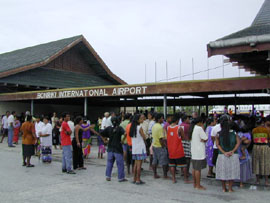 Junior reporter Junko was still inside the ramen shop squaring up the bill. She's a good kid; very understanding of the truism that gambling losses are always only temporary. Moments prior I had just finished explaining to her about my recent trip with my trusty driver to the South Pacific and Vanuatu's Santo Island when the chef decided to cut us off after one order of gyoza when he saw me adding powdered kava to the water glasses. No matter I told Junko that on the walk back I would continue with my next stop in...
Junior reporter Junko was still inside the ramen shop squaring up the bill. She's a good kid; very understanding of the truism that gambling losses are always only temporary. Moments prior I had just finished explaining to her about my recent trip with my trusty driver to the South Pacific and Vanuatu's Santo Island when the chef decided to cut us off after one order of gyoza when he saw me adding powdered kava to the water glasses. No matter I told Junko that on the walk back I would continue with my next stop in...
"Tarawa Atoll in Kiribati is what's next, right?" she asked in appearing on the sidewalk. I lit a Winfield and we turned back to the newsroom.
After arriving at Bonriki International Airport in South Tarawa, my driver got us a car. We had one road to choose from and we took it.
Tarawa is a C-shaped coral atoll in the South Pacific in the same geographical region as Fiji. But really that is like saying Anchorage is in the same region as Toledo because Tarawa isn't close to anything but water. Inside is a shallow lagoon and outside is the Pacific. Its highest landform is no more than 10 feet and it is split at its half-way point creating the division, passable only by boat, between North and South.
Sunshine, trade wind breezes, coral, coconuts, and ocean views of varying shades of blue, green, and turquoise are available daily and in plentiful amounts. Along the main road, palms sway in the afternoon trades and pigs hustle in between the abandoned concrete Japanese WWII bunkers. At the seaside, some folks swim and others fish. Yet still others sell fish. Perhaps paradise. That is, if you can find yourself something to drink and are able to assemble an ark inside of 50 years.
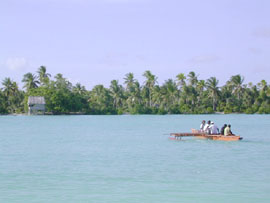 In the villages, composed mainly of concrete block or thatch homes, rainwater is collected in tanks, if it rains. Additionally, groundwater lenses are tapped with wells. But should the water's use be for consumption, it is boiled as incredible overcrowding in South Tarawa has led to bacteria contamination problems. Sometimes though you can have too much of a good thing.
In the villages, composed mainly of concrete block or thatch homes, rainwater is collected in tanks, if it rains. Additionally, groundwater lenses are tapped with wells. But should the water's use be for consumption, it is boiled as incredible overcrowding in South Tarawa has led to bacteria contamination problems. Sometimes though you can have too much of a good thing.
At low tide, the gentle slope of Tarawa's beaches creates a landform from ocean to lagoon with an average width of a standard city block. The main roadway that rolls over causeways and bridges from the airport in Bonriki to the atoll's end, in the relatively bustling village of Betio, splits the atoll's center. However at high tide, the ocean laps up against the sand dunes at the edge of the villages and main road for many stretches. During this time, the palms still sway, the pigs still play, and folks are still swimming, fishing, and selling, but there is one concern - for how much longer? With the greenhouse effect, Greenpeace gives them 50 to 100 years. The I-Kiribati don't seem worried about their fragile environment. I was only worried about where I could get a little refreshment.
"So where are we headed," I asked
"Betio. We can take in some sights on the way there. But first, we'll get us a bottle of kaokioki."
"What the heck's that?"
"A local drink, fermented coconut sap. Imagine a sour coconut toddy."
That's just what I wanted to hear.
My driver pulled us off to the side of the road at a small family restaurant and got out. He emerged again a few moments later with a bottle of bubbly white liquid - allegedly the kaokioki - and my wallet two Australian dollars lighter. The drink is made by draining the sap of a budding coconut into a bottle and allowing it to ferment for two days.
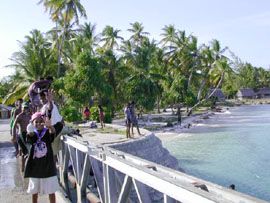 "Now we gotta find a place to drink it," he said.
"Now we gotta find a place to drink it," he said.
The drive to Betio is about 30 minutes. On the way we met some kids that were taking advantage of the afternoon high tide by leaping off the ocean side of a bridge so as to be swept into the lagoon by the rushing water. After crossing the causeway into Betio, we also saw the abandoned Japanese canons from WWII on the beach. They have been repainted by the government for preservation and are near some equally abandoned concrete bunkers and current I-Kiribati homes. Some point to the ocean, some point to the lagoon, and one has had its tip lopped off. Rumor says that an airplane crashed into it.
The Target Betio Saloon, in the center of Betio, is where we stopped. We entered and found a room that was dimly lit with a scattering of lamps. I-Kiribati were seated at some of the half dozen tables. The drink of choice appeared to be Victoria Bitter, it usually is.
My driver got us a table across the room from the entrance and set down the bottle. I went up to the bar.
"Two VBs, my good man," I said to the bartender, a middle aged I-Kiribati.
We exchanged brief greetings. I spun the wheel of my lighter without initiating the flint.
"You know, I spent a week in LA on my way back from going to school in London," he said while digging two of the South Pacific's most prevalent beers out of a cooler. "Outside the airport I saw a policeman and I wanted to ask him for directions. But as I got closer I saw that he had two large pistols on his belt."
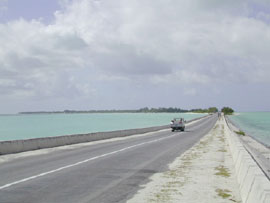 As I was talking to the bartender, I could overhear a conversation my driver was having with an elderly woman, the only foreigner in the room other than us, seated at the table next to him.
As I was talking to the bartender, I could overhear a conversation my driver was having with an elderly woman, the only foreigner in the room other than us, seated at the table next to him.
"So what's your name?" he asked.
"Amelia," she said.
"Been here long?"
"A number of years."
My driver then motioned for me to get three glasses as well.
"I was scared and couldn't ask him anything," the bartender continued. "In fact, after I got to my hotel, I never went outside because I couldn't stop thinking about those two pistols." I extended my pack of smokes to him as a means of apology. He politely declined and handed me the drinks and glasses. I started back for our table.
"You need a wife? You can get one here real easy," he said.
"I'll let you know," I called back as I got to our table.
My driver poured us out three slugs of the kaokioki. We all tipped them back.
"That's good stuff," Amelia remarked. Indeed, it is sort of like drinking light bicarbonate milk with a hint of coconut. I offered her a smoke and I cracked my beer.
Just then the doors of the saloon swung open. A tall and thin gentleman stepped inside. His head turned slowly from side to side, scanning the room. The bright sun, reflected off the white crushed coral side street outside, poured in from behind him. The saloon doors took their sweet time in swinging back shut.
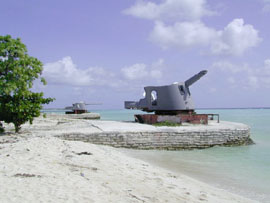 His head finally stopped at our table and he pointed. "Amelia Earhart, I have been in search of you for 25 years now! I have overturned every piece of broken coral and sifted every grain of sand from Papua New Guinea to Samoa. And now!" His head turned toward the ceiling and his hands made fists. "Now, in the confines of the Target Betio Saloon in Tarawa, Kiribati I have found you!"
His head finally stopped at our table and he pointed. "Amelia Earhart, I have been in search of you for 25 years now! I have overturned every piece of broken coral and sifted every grain of sand from Papua New Guinea to Samoa. And now!" His head turned toward the ceiling and his hands made fists. "Now, in the confines of the Target Betio Saloon in Tarawa, Kiribati I have found you!"
By this time, the doors had fully closed behind him and the dim house lights had begun to take effect. He was no longer a silhouette. He was Leonard Nimoy.
"Ah hell!" Amelia exclaimed. She tossed her smoke into the ashtray on the table and set down her glass. Her right hand slowly moved to her lowering forehead. "I knew this day would come eventually," she muttered.
Leo approached our table.
"You know," she started, her head rising, "A few years back I used to watch reruns of your show on a satellite feed in this very bar. When the ending credits would roll and the picture of me and my plane would come up, I would just laugh and laugh."
"It doesn't matter now. All I have to do is get my camera crew to fly out here and..."
"Well Leo," I interrupted, "I'm not sure what business you have here but if anyone found her it was me and my driver here." I pointed at my grinning partner. "We've been here enjoying some pleasant conversation and this here kaokioki for some time now."
Leo took a step back, almost as if he were recessing into a shell of his former self.
Back at the newsroom I stretched my arms and put my feet on my desk next to my empty coffee cup. Junko was standing in my doorway.
"You didn't know the story of Amelia Earhart?" she asked with a tone of amazement.
"I guess she used to fly airplanes or something back a few years ago."
"So what did Leo end up doing?"
I spun my chair around and faced my office window.
"Ah, he said something about having to head off on another project and was going to meet with a specialist in submarine navigation of Britain's lochs. Coincidentally," I started to turn my chair back and extend my right arm, "I have my own little project that I am working on..."
But I stopped halfway. I already knew she was gone. I am beginning to develop a sense with her. My project remains: In search of a cup of coffee.

